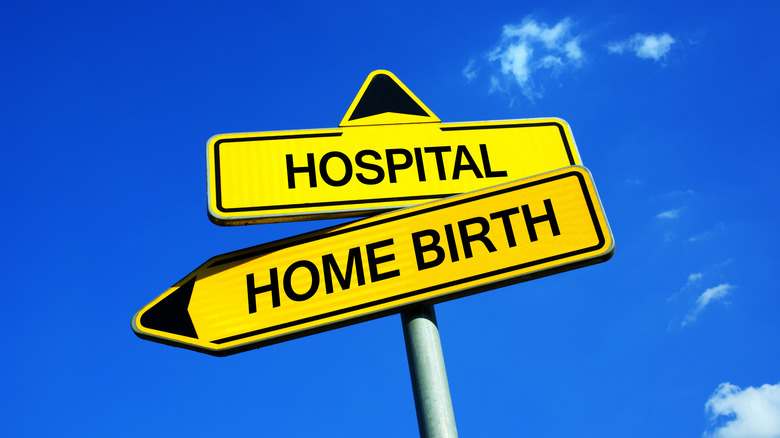Midwife Heidi Ricks Reveals What A Home Birth Is Really Like - Exclusive
Pregnancy is a journey filled with many decisions, both big and small. You have to decide what to name your baby, whether you'll use cloth versus disposable diapers, and who your pediatrician will be. One of the first and most important decisions to make, however, is where to give birth and who your provider will be. While many births still occur in hospital and clinical settings, planned home births saw an increase during the COVID-19 pandemic, per the Centers for Disease Control and Prevention (CDC). To learn more about the ins and outs of home birth, Licensed Midwife Heidi Ricks shared what the process is really like in an exclusive interview with Health Digest.
"Midwives licensed in NY are independent practitioners offering full scope midwifery care throughout the reproductive years and beyond," explains Heidi. "Many people don't realize that midwives offer GYN care, have prescriptive privileges, [and] work in a variety of settings including home, hospital birth centers, and clinics."
The many differences between a home birth versus a hospital birth
Planned home births are unique in that there is more opportunity for individualized care thanks to a smaller setting. That means longer visits and more opportunities to talk about how you're doing as well as any challenges you might be facing.
"As we are not constrained by an industrialized system, we are able to individualize care in a way that is not always possible in a larger system," Heidi explains. "Our clients are at the center of their care and are given options for their care with the guidance of evidence-based education throughout the pregnancy."
This individualized care also includes a wide network of other specialists who can provide services to the birthing parent. "The folks we refer to most are MFM (Maternal Fetal Medicine), massage therapists, chiropractors, acupuncturists, breastfeeding support, mental health specialists, childbirth educators, endocrinologists, physical therapists," says Heidi. "Every midwife has a large network available to support her clients as needed."
As far as safety is concerned, Heidi shares that midwives are trained to recognize any risks that may develop during the prenatal period or during labor so they can act accordingly to best support the well-being of both parent and baby. She explains, "Research has shown that home birth with a trained midwife in a well-integrated health care system is as safe as a hospital for healthy pregnancies," (via The Lancet).
Pain management in home births
One of the biggest questions someone considering a home birth may have is how to cope with the pain of childbirth without an epidural or other similar pain management outlets that hospitals usually offer. Heidi explains that the months of prenatal visits with your midwife talking about the labor process, having control of your surroundings and your support people, and knowing what to expect makes all the difference. "Pain is experienced more intensely when a person feels unsupported, out of control, or does not understand what is causing the pain. If people know what to expect from the labor process and trust the people supporting them, their experience of pain can be very different than those in an unfamiliar setting with people they have never met and with an unknown set of rules being applied to their process."
Heidi shares that the use of water can be an incredibly helpful pain management tool as well. "Many clients choose to use water for comfort in either their own shower or tub or in birth pools we provide. Some clients who have given birth without a pool in the past say that the experience of having a pool is equivalent to having an epidural."
Midwifery's emphasis on postpartum care
The postpartum period is often an overwhelming and vulnerable time, especially if you are a new parent, but the midwifery care model is structured in a way that allows you to feel supported throughout those first weeks of your baby's life. As Heidi explains, "Home birth midwives usually see clients in their homes several times in the first few weeks after birth. We are checking in not just on the birthing parent's physical well-being, but also on the newborn and the family as a whole: we are checking to see that the support networks are showing up as expected, that baby feedings are going well, that referrals are made as necessary for mother/baby, that adequate rest and nutrition are happening."
Emphasis on the postpartum period is a large part of the midwifery care model and many prenatal visits you have with your midwife team will center on your postpartum plans, expectations, and setting up support networks. "The fact that we have had time to know our clients and their individual situations helps us to guide them to create a plan that works to support the entire family during a time of great transition, thus preventing severe postpartum mood disruptions as much as possible," says Heidi. "We have become a trusted resource where both partners know they can turn if things are not going well."
To find out more about Heidi Ricks, visit the HeartSpace Midwifery website.




